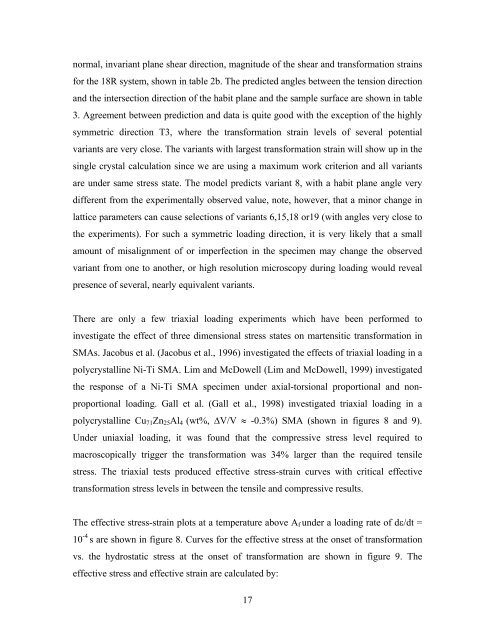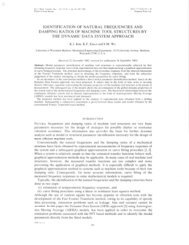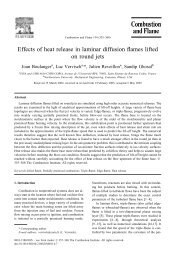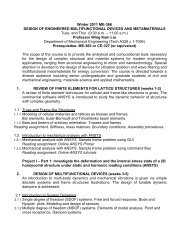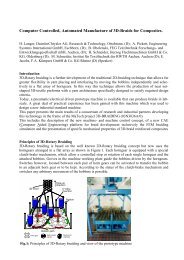A Simplified Multivariant SMA Model Based on Invariant Plane ...
A Simplified Multivariant SMA Model Based on Invariant Plane ...
A Simplified Multivariant SMA Model Based on Invariant Plane ...
You also want an ePaper? Increase the reach of your titles
YUMPU automatically turns print PDFs into web optimized ePapers that Google loves.
normal, invariant plane shear directi<strong>on</strong>, magnitude of the shear and transformati<strong>on</strong> strains<br />
for the 18R system, shown in table 2b. The predicted angles between the tensi<strong>on</strong> directi<strong>on</strong><br />
and the intersecti<strong>on</strong> directi<strong>on</strong> of the habit plane and the sample surface are shown in table<br />
3. Agreement between predicti<strong>on</strong> and data is quite good with the excepti<strong>on</strong> of the highly<br />
symmetric directi<strong>on</strong> T3, where the transformati<strong>on</strong> strain levels of several potential<br />
variants are very close. The variants with largest transformati<strong>on</strong> strain will show up in the<br />
single crystal calculati<strong>on</strong> since we are using a maximum work criteri<strong>on</strong> and all variants<br />
are under same stress state. The model predicts variant 8, with a habit plane angle very<br />
different from the experimentally observed value, note, however, that a minor change in<br />
lattice parameters can cause selecti<strong>on</strong>s of variants 6,15,18 or19 (with angles very close to<br />
the experiments). For such a symmetric loading directi<strong>on</strong>, it is very likely that a small<br />
amount of misalignment of or imperfecti<strong>on</strong> in the specimen may change the observed<br />
variant from <strong>on</strong>e to another, or high resoluti<strong>on</strong> microscopy during loading would reveal<br />
presence of several, nearly equivalent variants.<br />
There are <strong>on</strong>ly a few triaxial loading experiments which have been performed to<br />
investigate the effect of three dimensi<strong>on</strong>al stress states <strong>on</strong> martensitic transformati<strong>on</strong> in<br />
<str<strong>on</strong>g>SMA</str<strong>on</strong>g>s. Jacobus et al. (Jacobus et al., 1996) investigated the effects of triaxial loading in a<br />
polycrystalline Ni-Ti <str<strong>on</strong>g>SMA</str<strong>on</strong>g>. Lim and McDowell (Lim and McDowell, 1999) investigated<br />
the resp<strong>on</strong>se of a Ni-Ti <str<strong>on</strong>g>SMA</str<strong>on</strong>g> specimen under axial-torsi<strong>on</strong>al proporti<strong>on</strong>al and n<strong>on</strong>-<br />
proporti<strong>on</strong>al loading. Gall et al. (Gall et al., 1998) investigated triaxial loading in a<br />
polycrystalline Cu71Zn25Al4 (wt%, ∆V/V ≈ -0.3%) <str<strong>on</strong>g>SMA</str<strong>on</strong>g> (shown in figures 8 and 9).<br />
Under uniaxial loading, it was found that the compressive stress level required to<br />
macroscopically trigger the transformati<strong>on</strong> was 34% larger than the required tensile<br />
stress. The triaxial tests produced effective stress-strain curves with critical effective<br />
transformati<strong>on</strong> stress levels in between the tensile and compressive results.<br />
The effective stress-strain plots at a temperature above Af under a loading rate of dε/dt =<br />
10 -4 s are shown in figure 8. Curves for the effective stress at the <strong>on</strong>set of transformati<strong>on</strong><br />
vs. the hydrostatic stress at the <strong>on</strong>set of transformati<strong>on</strong> are shown in figure 9. The<br />
effective stress and effective strain are calculated by:<br />
17


